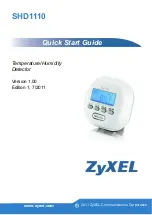
Chapter 43 Syslog Setup
GS1920v2 Series User’s Guide
372
C
HA PTER
4 3
Syslo g Se tup
43.1 Syslo g O ve rvie w
This chapter explains the syslog screens.
The syslog protocol allows devices to send event notification messages across an IP network to syslog
servers that collect the event messages. A syslog-enabled device can generate a syslog message and
send it to a syslog server.
Syslog is defined in RFC 3164. The RFC defines the packet format, content and system log related
information of syslog messages. Each syslog message has a facility and severity level. The syslog facility
identifies a file in the syslog server. Refer to the documentation of your syslog program for details. The
following table describes the syslog severity levels.
43.1.1 Wha t Yo u C a n Do
• Use the
Syslo g Se tup
screen (
Section 43.2 on page 372
) to configure the device’s system logging
settings and configure a list of external syslog servers.
43.2 Syslo g Se tup
The syslog feature sends logs to an external syslog server. Use this screen to configure the device’s
system logging settings and configure a list of external syslog servers.
Click
Ma na g e m e nt
>
Syslo g
in the navigation panel to display this screen.
Table 184 Syslog Severity Levels
C O DE
SEVERITY
0
Emergency: The system is unusable.
1
Alert: Action must be taken immediately.
2
Critical: The system condition is critical.
3
Error: There is an error condition on the system.
4
Warning: There is a warning condition on the system.
5
Notice: There is a normal but significant condition on the system.
6
Informational: The syslog contains an informational message.
7
Debug: The message is intended for debug-level purposes.
















































